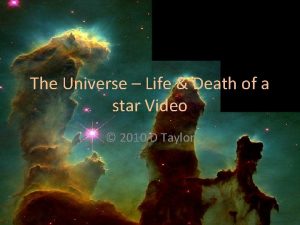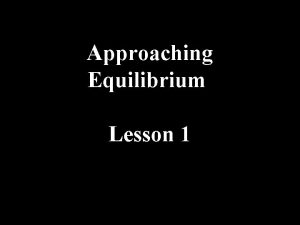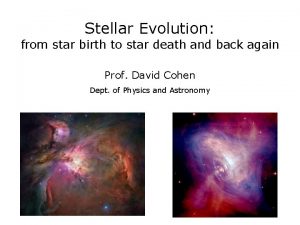The Death of a Star Approaching Death The






























- Slides: 30

The Death of a Star


Approaching Death • The star has fused the hydrogen in the core. • The core begins to collapse. • More stellar material begins to fall into the core • This results in further core heating.


Shell Burning • The hydrogen lying just above the core begins to fuse. • This shell burning causes the enormous expansion of the outer layers of the star. • The star has now become a red giant


Red Giants • Typically between 0. 4 & 8 Solar Masses • A star of around the sun’s mass will expand to a diameter around the size of the Earth orbit. • A star of this mass cannot hold on to its outer material and this is lost into space. Other material falls onto the core. This leaves a highly dense core remnant. • The remnant is a White Dwarf.





White Dwarfs • The white dwarf is super dense. Density 109 kgm 3 • Electron degeneracy pressure is the only force holding the electrons from being squeezed into the nuclei. • A white dwarf has the diameter of a terrestrial planet.


Supernovas • For very large stars the no outer material is lost and matter falling onto the core increases the pressure until the electron degeneracy pressure is exceeded and electrons are forced into nuclei. • This produces a massive rebound shockwave which blows the star apart as a supernova.



Pulsars • The core remnant of a supernova is a neutron star or pulsar. • These objects are incredibly dense squeezing over 2. 5 solar masses into a diameter of around 20 km. • They have intense magnetic fields which focus electromagnetic radiation into beams at the poles, They spin rapidly.

Neutron stars can look like ordinary faint stars through an optical telescope. Or if they are recent we may see the expanding shell of gas of the supernova explosion they were created in. Gamma rays from the Vela pulsar They are spinning rapidly and produce regular directional pulses in the radio spectrum. Many are strong X ray or gamma sources

The intense magnetic field of the pulsar concentrates the electromagnetic radiation into two focussed beams emitted from the poles (shown in green). We receive regular pulses if we are in the path of the beam as it sweeps.

Black Holes • When super massive stars collapse the neutrons collapse. • A central infinitely dense SINGULARITY is produced. • There is a region surrounding the singularity from which light cannot escape. • The EVENT HORIZON is the boundary of the black hole

Detecting Black Holes • Black holes are surrounded by Accretion disks which emit X-rays. • These accretion disks can produce jets of material at right angles. • Black holes bend light which passes close to them. This gravitational lensing can be observed when a distant galaxy lies behind a black hole.








>10 Ms Red Giant supernova White dwarf Red Giant supernova Pulsar Black hole

White Dwarf Neutron Star Black Hole Typical mass >0. 8 Ms of original star Mass of core <1. 4 Ms remnant >10 Ms ~ 40 Ms >1. 4 Ms >2. 5 Ms Typical diameter of remnant Density of remnant About Earth Size 30 km 20 km 109 kgm 3 4 x 1017 kgm 3 (infinite at singularity)
 Bearing gifts we traverse afar
Bearing gifts we traverse afar Difference between a star and ao star
Difference between a star and ao star What does star (for star events) stand for?
What does star (for star events) stand for? Star life cycle from birth to death
Star life cycle from birth to death The life and death of a star
The life and death of a star Star life cycle from birth to death
Star life cycle from birth to death Beetlejuice planet size
Beetlejuice planet size Selection of direct retainers
Selection of direct retainers Exceeding meeting approaching
Exceeding meeting approaching Approaching vehicle audible system
Approaching vehicle audible system You are coming up to a roundabout a cyclist
You are coming up to a roundabout a cyclist Great gatsby chapters 8-9 summary
Great gatsby chapters 8-9 summary Circumferential clasp and bar clasp
Circumferential clasp and bar clasp A martian lander is approaching the surface
A martian lander is approaching the surface How does the approaching ceremony of twelves affect jonas
How does the approaching ceremony of twelves affect jonas Bar clasp rpd
Bar clasp rpd The sound of the approaching grain teams
The sound of the approaching grain teams Approaching meeting exceeding
Approaching meeting exceeding Approaching differences diagram
Approaching differences diagram Somatic and molecular death
Somatic and molecular death Chụp tư thế worms-breton
Chụp tư thế worms-breton ưu thế lai là gì
ưu thế lai là gì Tư thế ngồi viết
Tư thế ngồi viết Cái miệng nó xinh thế
Cái miệng nó xinh thế Các châu lục và đại dương trên thế giới
Các châu lục và đại dương trên thế giới Mật thư anh em như thể tay chân
Mật thư anh em như thể tay chân Bổ thể
Bổ thể Tư thế ngồi viết
Tư thế ngồi viết Giọng cùng tên là
Giọng cùng tên là Thẻ vin
Thẻ vin Thơ thất ngôn tứ tuyệt đường luật
Thơ thất ngôn tứ tuyệt đường luật






















































